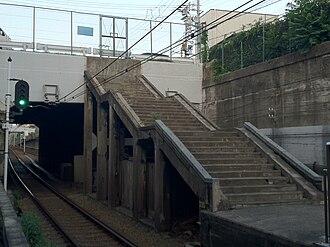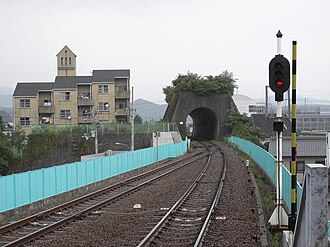Types of Thomasson
Based on the categories in Chikuma Shobō’s “Thomasson Illustrated Encyclopedia” (Tomason Daizukan トマソン大図鑑)
The Useless Staircase

(Japanese: Muyō kaidan 無用階段)
Also known as a Pure Staircase. A staircase that only goes up and down. Most used to have a door at the top. Some useless staircases exist that were useless right from completion, due to changes or mix-ups in the design.
The Useless Doorway
(Japanese: Muyō mon 無用門)
Even though it has been blocked up, a Useless Doorway still maintains the majesty of its original purpose. In other cases, a Useless Doorway exists in a place that has no need for it, with no wall or fence around it.
The Hisashi
(Japanese: Hisashi ヒサシ)
Hisashi is the word for “eaves” in Japanese. This refers to useless eaves: ones that no longer have a window or door underneath them to protect from the rain.

The Useless Window
(Japanese: Muyō mado, 無用窓)
A blocked up window: one which is still beautiful due to the care taken in blocking it up.
The Nurikabe
(Japanese: Nurikabe ヌリカベ)
Nurikabe is the word for “plaster wall” in Japanese. This overlaps with the Useless Doorway and Useless Window categories. It refers to a door or window that was meant to be completely sealed up with concrete, but a difference can still be seen between it and the surrounding area.
The A-bomb type
(Japanese: Genbaku taipu 原爆タイプ)
A 2-D Thomasson. The outline of a building that remains in silhouette on a wall. This can be seen when a section of a tightly packed row of buildings is torn down. Cases that appear due to water are known as hydrogen bombs (suibaku 水爆). Cases that appear when a hoarding or sign is torn down are known as neutron bombs (chūseishibakudan 中性子爆弾).

The Elevated type
(Japanese: Kōsho 高所)
These objects are normal themselves, but exist in a higher than normal place, therefore seeming strange. For example, a door with a handle on the second floor of a wall. These often appear when staircases are torn down. They can also appear when a winch or crane is kept inside the building, but a standard door is used on the outside.
The Outie
(Japanese: Debeso でべそ)
A protrudence from a sealed up wall, such as a door knob or tap.
The Uyama
(Japanese: Uyama ウヤマ)
A sign or hoarding with letters missing. The first example of this was a shop sign which contained the words Uyama, but the rest of the lettering was missing, hence the name.
The Castella
(Japanese: Kasutera カステラ)
A cuboid protuberance from a wall, named after Castella, a Japanese sponge cake. For example, a blocked up window which sticks out from the wall. The opposite of this, a sunken blocked up section, is known as a Reverse Castella.
The Atago
(Japanese: Atago アタゴ)
An object sticking out at the side of the road, with no clear purpose, possibly used to stop cars parking. The first example of this was found by Akasegawa whilst walking from Shinbashi to Atago, hence the name.
The Live Burial
(Japanese: Ikiume 生き埋め)
A roadside object which is partly submerged in concrete.
The Geological layer
(Japanese: Chisō 地層)
A patch of ground that is different in height from that around it, usually where multiple construction works have taken place.
The Boundary
(Japanese: Kyōkai 境界)
A guardrail, fence or wall whose purpose is not immediately clear.
The Twist
(Japanese: Nejire ねじれ)
A part of a building which is normally meant to be straight, but is slightly twisted. Often seen when an object that was created to be used straight is used at an angle.
The Abe Sada
(Japanese: Abe Sada 阿部定)

The remains of a telephone pole cut down. The name refers to the Abe Sada Incident; a famous case from 1930s Japan in which a woman strangled her lover and then severed his genitalia with a kitchen knife.
The Devouring Tree
(Japanese: Monokūki もの喰う木)
A tree which absorbs part of a fence or wire whilst still growing. However, this is not a particularly rare phenomenon, and occurs quite often. If there is no human involvement then it cannot be called a Thomasson, just a natural phenomenon. This is also known as the Stubborn Nature Type (shizen kohashi taipu 自然強しタイプ).
The Useless Bridge
(Japanese: Muyō bashi 無用橋)
A bridge over a filled-in river, or a bridge that has become useless. In the case of some covered drains, a bridge is still necessary for cars or heavy vehicles to cross. In this case these could not be called Useless Bridges, as they only appear useless.
The Pure type
(Japanese: Junsui taipu 純粋タイプ)

An uncategorizable object whose use it is impossible to fathom. For example, the Pure Shutters, which open to reveal a blank wall, and the Pure Tunnel that exists without a surrounding hill. The Pure Staircase of Yotsuya belongs in this category.
Evaporation
(Japanese: Jōhatsu 蒸発)
The fading of color on a sign, or a monument with parts missing: an object whose meaning has become hard to work out. Cases often appear due to the long-lasting material of the object. This also often occurs when a sign’s key phrases, painted in red for emphasis, disappear, leaving the rest of the sign hard to understand.